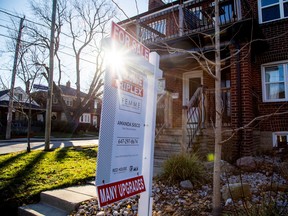Adviser suggests using the RRSPs first and then the TFSAs, and strive to have a 20-per-cent down payment to avoid CMHC fees

Reviews and recommendations are unbiased and products are independently selected. Postmedia may earn an affiliate commission from purchases made through links on this page.
Article content
By Julie Cazzin with Doug Robinson
Advertisement 2
Article content
Q: My partner Miranda and I will be buying our first home later this year. Should we use money from our registered retirement savings plans (RRSPs), tax-free savings accounts (TFSAs) or both to make a down payment? We have about $60,000 in each of our TFSAs and $20,000 each in our RRSPs. What are the pros and cons of drawing funds for this purpose from each of these accounts? We also have $40,000 in a savings account that we are using as an emergency fund, so we weren’t planning on using those funds for the down payment. — Felix
Article content
FP Answers: Felix, you and Miranda have done an excellent job of saving money to buy a home together. I am encouraged to know you have an emergency fund of $40,000 set aside. This makes answering your question easier. Far too many people underestimate the importance of these savings.
Advertisement 3
Article content
Lenders want 20 per cent of the purchase price as a down payment when buying a home, or you will need mortgage insurance, which comes at a cost to you. If you used all the money in your TFSA and RRSP accounts, you would have $160,000 available. You could buy a property priced up to $800,000 and not have to incur the Canada Mortgage and Housing Corp. (CMHC) insurance cost, which ranges from 2.4 per cent to four per cent of the mortgage amount. For example, if you need a $500,000 mortgage, the low end of the CMHC insurance cost is $12,000. Having 20 per cent for a down payment can save you a lot of money. Ideally, I would strive for a 20-per-cent down payment.
If I assume you purchase a property for $600,000, you would be targeting a down payment of $120,000. If you use your RRSP, you will be required to pay the amount back to your RRSP over the next 15 years, commencing the second year after you purchase your home. In this example, you will both need to repay $1,333 a year if you each use all your RRSPs. If you don’t make a repayment, the missed payment is added to your income that year, and you must pay tax on that amount. You should evaluate if making these repayments will fit your budget.
Advertisement 4
Article content
Earnings in an RRSP are fully taxed when they are withdrawn. However, gains in your TFSA are completely tax free forever. If you have $20,000 invested over the next 30 years, it will grow to about $100,000 at a 5.5-per-cent return. All $100,000 would be taxed upon withdrawal if the money was in your RRSP. If it was in your TFSA, none is taxable.
The clear winner is the TFSA, implying you should draw funds out of your RRSP first as the down payment. The advantage of the RRSP is that you benefit from a tax deduction at the time of contribution. However, you have already received that tax deduction, so allowing your TFSA to grow rather than your RRSP makes better financial sense.
-

FP Answers: What are the tax implications of joint investment accounts?
-

FP Answers: What’s the most tax efficient way to draw down my $5-million investment portfolio?
-

FP Answers: Do I really need 70% of my working income to retire comfortably?
-

FP Answers: Can I save tax by transferring an investment property to a corporation?
Advertisement 5
Article content
We could consider taking this further for you. If you and Miranda have more RRSP room, you could contribute some of your TFSA money to an RRSP right now and get an immediate tax deduction for the 2022 taxation year. If the funds are in the RRSP for more than 90 days before you withdraw them to buy your home, this will work. Using the Home Buyers’ Plan (HBP), the maximum withdrawal from an RRSP is $35,000. If you added another $15,000 to your RRSP from your TFSA, you could benefit from the tax deduction immediately.
Such a strategy works most effectively if your taxable income for the year is more than roughly $50,000 after all deductions, including the RRSP amount. Your tax savings on such a contribution would start at about $4,500 and could be significantly more if your income is higher. It would be best to get more specific tax advice before considering this option, but it may work well for one or both of you. Unlike an RRSP, the amount you withdraw from a TFSA will be added back to your contribution limit the following year. Therefore, this strategy won’t hurt your future TFSA contribution room.
Advertisement 6
Article content
I strongly lean toward using your RRSP first and then your TFSA, and striving to have the full 20-per-cent down payment to avoid CMHC fees. Maintaining your emergency fund on top of this strategy protects you from challenges that are likely to arise. Leaving some money invested in your TFSA for the future is an excellent foundation for long-term financial success. I wish you success and years of enjoyment in your home.
Doug Robinson is a certified financial planner and wealth adviser with Veritable Wealth Advisory in Peterborough, Ont. Veritable Wealth Advisory is a full-service financial planning and investment firm that employs multiple certified financial planners and portfolio managers with offices in Burlington, Kingston and Peterborough.
_____________________________________________________________
For more stories like this one, sign up for the FP Investor newsletter.
______________________________________________________________

